全文HTML
--> --> -->国内外众多研究机构对掺镱光纤的辐照特性进行了广泛研究, 然而关于掺镱光纤在中子辐照条件下对性能的影响及暗化影响因素研究较少. 中子是不带电粒子, 研究发现, 中子辐照可以使光纤材料发生原子位移损伤. 并且在中子辐照过程中当位移原子带有较高能量时, 原子核会将能量传递给束缚电子, 使电子激发由低能级跃迁到高能级, 当电子获得的能量足够大时, 它便能脱离原子核的束缚成为自由电子, 产生原子电离效应. 高能中子辐照还能与原子发生核反应生成次级辐射粒子, 与光纤进行次级相互作用[9]. 辐致暗化效应与掺镱光纤中掺杂离子(Al, P, Ce等)的关系已经被很多研究机构关注并进行了研究[10-12]. 掺杂Al或P离子可以减少稀土离子团簇[13], 但Al离子浓度过高可能会产生Al-OHC, 导致暗化现象[14]; P离子掺杂可能会与Al结合生成AlPO4, 从而降低光纤的折射率[15]. 目前这些掺杂离子在辐照中起到的作用仍不清楚, 但是研究表明, 这些掺杂离子是辐照后造成光纤输出损耗的主要原因之一[16,17]. 掺杂变价离子可以提高掺镱光纤的抗辐照性能, 变价离子的抗辐照性能与其氧化还原性有关. 辐照过程中, 由于变价离子可先跟电离电子进行价态转换, 能够给光纤的辐照反应提供缓冲空间, 从而提高其抗辐照性能. 其中铈(Ce)掺杂对光纤的抗辐照能力有增强作用[18]. 光纤的后处理技术中光退火和热退火已经证明对光纤暗化有漂白作用[19,20]. 对光纤采取热退火, 能有效抑制辐致暗化效应, 且在一定的温度范围内, 温度越高、退火时间越长, 消除暗化的效果越好. 不过目前对中子辐照掺镱光纤的热退火研究及机理相关报告较少.
本文通过测试分析掺镱光纤材料中子辐照前后的吸收光谱, 研究掺杂离子(Al/Ce)对辐照前后掺镱光纤材料光学特性的影响. 之后对辐照后的掺镱光纤预制棒进行热退火处理, 测试分析热退火对辐照后掺镱光纤预制棒光学性能的影响.
2.1.样品参数及实验条件
实验所用的光纤预制棒及掺镱光纤均采用改进型化学气相沉积法结合稀土螯合物气相掺杂法制备[21,22]. 光纤为双包层掺镱光纤, 纤芯直径20 μm, 内包层直径400 μm. 光纤预制棒样品的厚度为2 mm, 双面抛光. 光纤及预制棒的中子辐照均用中国工程物理研究院快中子辐照装置, 中子能量1 MeV, 装置运行功率300 W. 辐照的注量率为4.5 × 1010 n·cm–2·s–1, 光纤的中子辐照注量为6.5 × 1014 n/cm2, 预制棒辐照注量为8.5 × 1014 n/cm2. 掺镱光纤(1#和2#)和预制棒(S1和S2)均采用EPMA(电子探针显微分析)对掺杂元素进行了分析. 元素分析结果如表1所列. 两种光纤中Yb, Al的掺杂浓度和比例较一致, 2#光纤的掺杂元素中有Ce离子. 两种预制棒中Yb的掺杂浓度相似, S2中Yb/Al掺杂比例为S1的0.5倍, 且掺杂了Ce离子.| No. | Doping concentration/mol% | ||
| Yb | Al | Ce | |
| 1# | 0.06 | 0.51 | 0 |
| 2# | 0.05 | 0.53 | 0.02 |
| S1 | 0.13 | 0.78 | 0 |
| S2 | 0.11 | 1.56 | 0.02 |
表1光纤及预制棒的EPMA元素分析
Table1.Electron probe microanalysis (EPMA) of optical fibers and optical fiber preforms.
预制棒样品在辐照后进行了热退火实验. 使用管式退火炉在空气氛围条件下进行退火, 升温速度为100 ℃/h, 在500 ℃恒温3 h. 降温到室温后进行光学测试.
2
2.2.测试方法
掺镱光纤吸收谱测试系统如图1所示, 光谱仪测试范围350—1100 nm. 光纤吸收使用截断法测试, 即测量同一根光纤在不同长度下的光功率, 计算表达式为 图 1 光纤吸收谱测试系统
图 1 光纤吸收谱测试系统Figure1. The absorption spectra of optical fibers measurement configuration.



掺镱光纤预制棒样品的吸收光谱使用Lambda950吸收分光光度系统测试, 测试波长范围200—1500 nm, 测试步长为1 nm. 预制棒荧光寿命测试采用FLS-980型荧光光谱仪测试, 使用激发波长为916 nm的LD(半导体激光器)脉冲光源.
3.1.中子辐照对掺镱光纤材料吸收的影响
首先测试了掺镱光纤预制棒辐照前后的吸收光谱(图2). 辐照后, 光纤预制棒S1的芯棒在200—800 nm区域内吸收强度明显增加, 且颜色由无色变为棕黑色(图2(a)). 掺杂Ce离子的预制棒S2的芯棒在200—400 nm有较强的吸收峰, 且辐照后吸收强度有一定的增强, 400—800 nm处的吸收在辐照后吸收略有增强, 芯棒由无色变成棕色(图2(b)). 从图2可以看出, 中子辐照会使掺镱光纤材料中产生大量色心缺陷, 使其在可见光区域产生明显吸收. Ce离子的掺杂可一定程度地抑制辐致缺陷的产生, 从而使掺镱光纤材料在可见光波段的吸收不发生明显的变化[23]. 从图2中可以看出, 掺镱光纤材料经过中子辐照后, Yb3+本身的吸收峰峰位、半高宽和吸收系数在辐照前后基本没有发生变化, 说明镱离子的周围配位场环境未受到明显影响[4,14].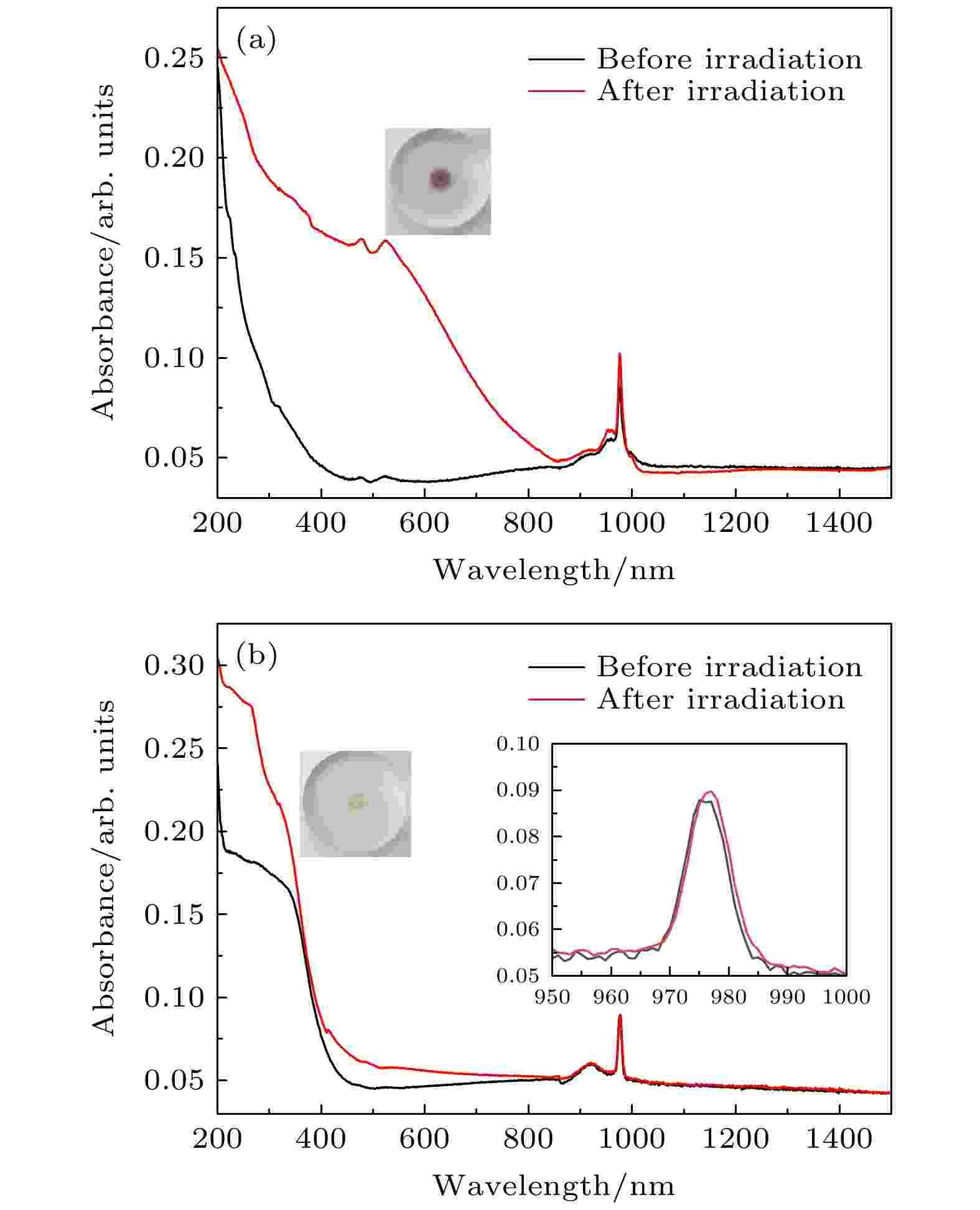 图 2 辐照前后 (a)掺镱光纤预制棒S1吸收光谱和(b)掺镱光纤预制棒S2吸收光谱, 图(b)中的插图给出了980 nm附近的放大图
图 2 辐照前后 (a)掺镱光纤预制棒S1吸收光谱和(b)掺镱光纤预制棒S2吸收光谱, 图(b)中的插图给出了980 nm附近的放大图Figure2. Absorption spectra of (a) optical fiber preform S1 and (b) optical fiber preform S2 before and after irradiation, the insets of panel (b) show the enlarged views near 980 nm.
为进一步研究辐致缺陷的产生过程以及Ce离子对中子辐致缺陷的影响, 对辐照后的预制棒S1和S2吸收光谱进行了高斯拟合(图3、图4). 从图3可看出, 光纤预制棒S1芯棒经辐照后产生的辐致缺陷主要为302 nm的Al-E′缺陷[24]和Al-OHC缺陷(417, 579 nm)[25,26]. 预制棒S2辐照后在200—400 nm的吸收是Ce3+ (211, 318 nm)的吸收峰(图4)[18], 可见光区域的吸收为Al-OHC (477, 579 nm) 缺陷的吸收峰. 掺杂Ce离子的预制棒S2在辐照后虽有Al-OHC缺陷的特征吸收峰, 不过峰强远低于光纤预制棒S1, 说明Ce离子的掺杂可有效缓解Al-OHC等色心缺陷的增加, 可在一定程度上抑制中子辐致暗化效应.
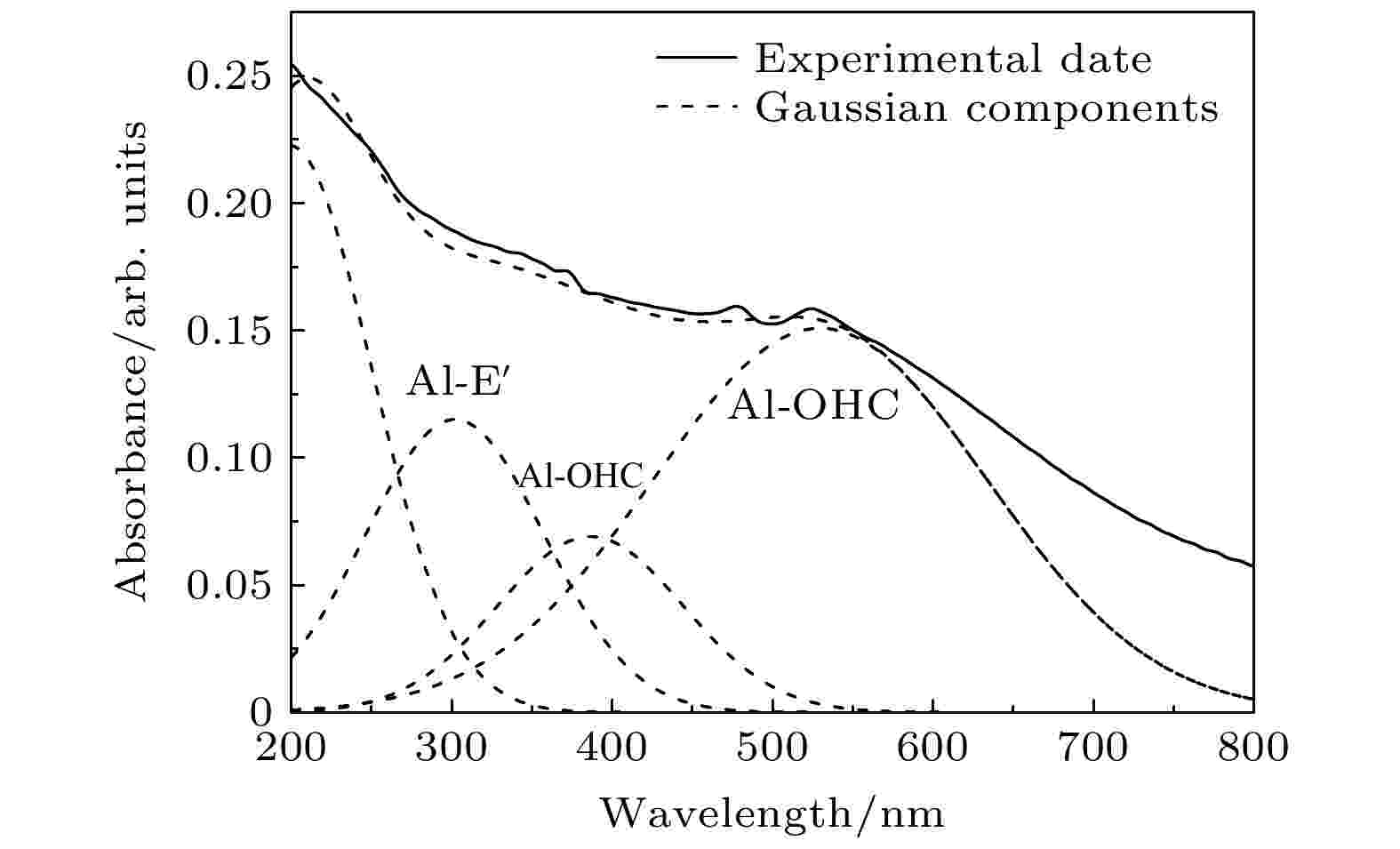 图 3 S1光纤预制棒辐照后实验数据及高斯拟合
图 3 S1光纤预制棒辐照后实验数据及高斯拟合Figure3. Experimental date and decomposition with Gaussian of S1 optical fiber preform after irradiation.
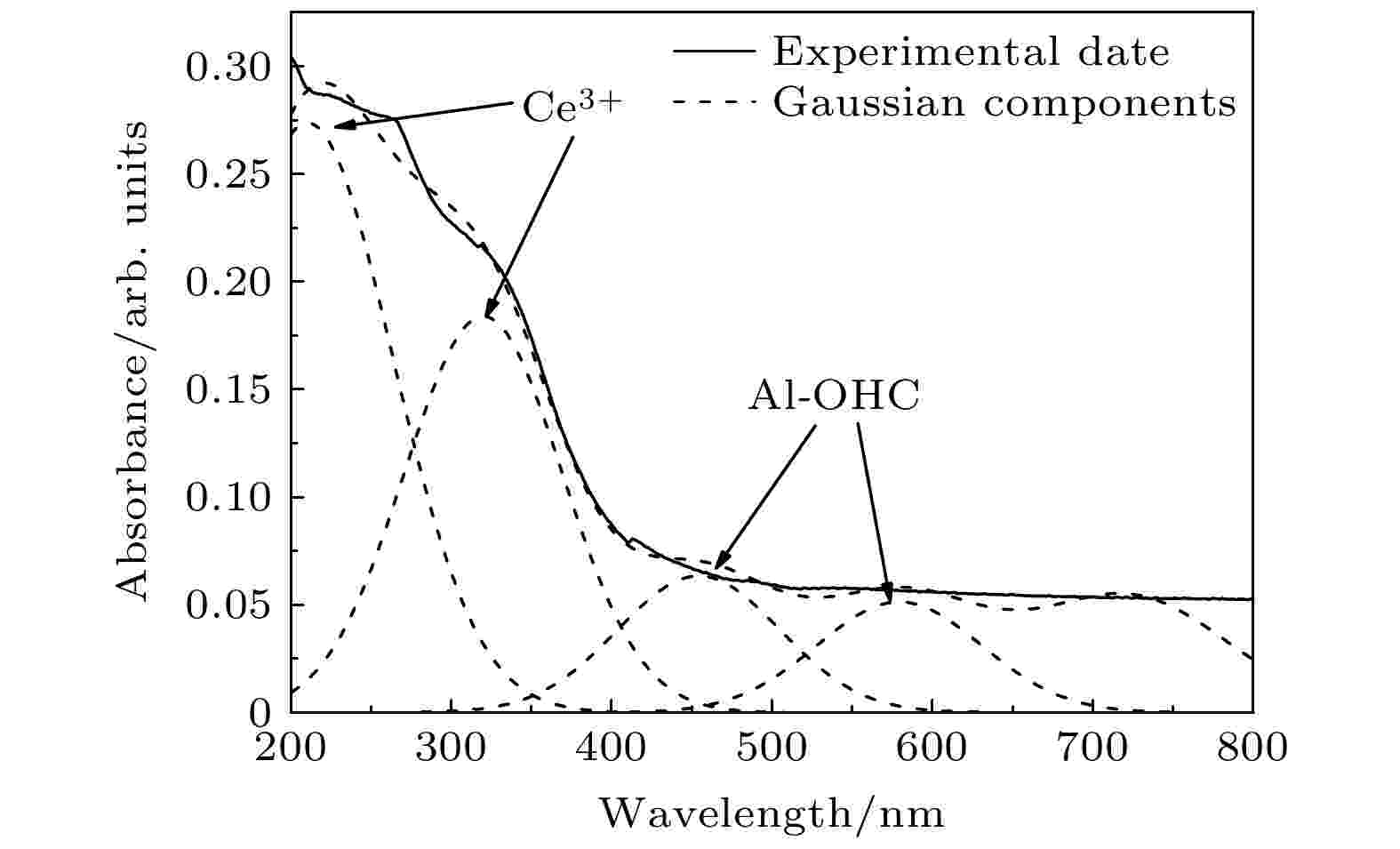 图 4 S2光纤预制棒辐照后实验数据及高斯拟合
图 4 S2光纤预制棒辐照后实验数据及高斯拟合Figure4. Experimental date and decomposition with Gaussian of S2 optical fiber preform after irradiation.
Al-OHC等色心缺陷的产生可以用辐致色心缺陷转变模型解释[27,28]. 如图5所示, 中子辐照过程中光纤材料首先发生原子位移损伤, 然后进一步发生电离效应产生一系列电子和空穴. 而光纤材料在制备过程中本身存在一定的杂质或初始缺陷, 这些缺陷可能是位于导带与电子相关的缺陷或是位于价带与空穴相关的缺陷. 电离产生的电子、空穴对会俘获价带中空穴的缺陷形成了与空穴相关的色心缺陷, 或者俘获导带中电子的缺陷形成了与电子相关的色心缺陷. 辐照后这些新色心缺陷造成掺镱光纤材料在可见光区域的吸收增强[29]. 掺镱光纤材料中辐致色心缺陷形成过程如下:
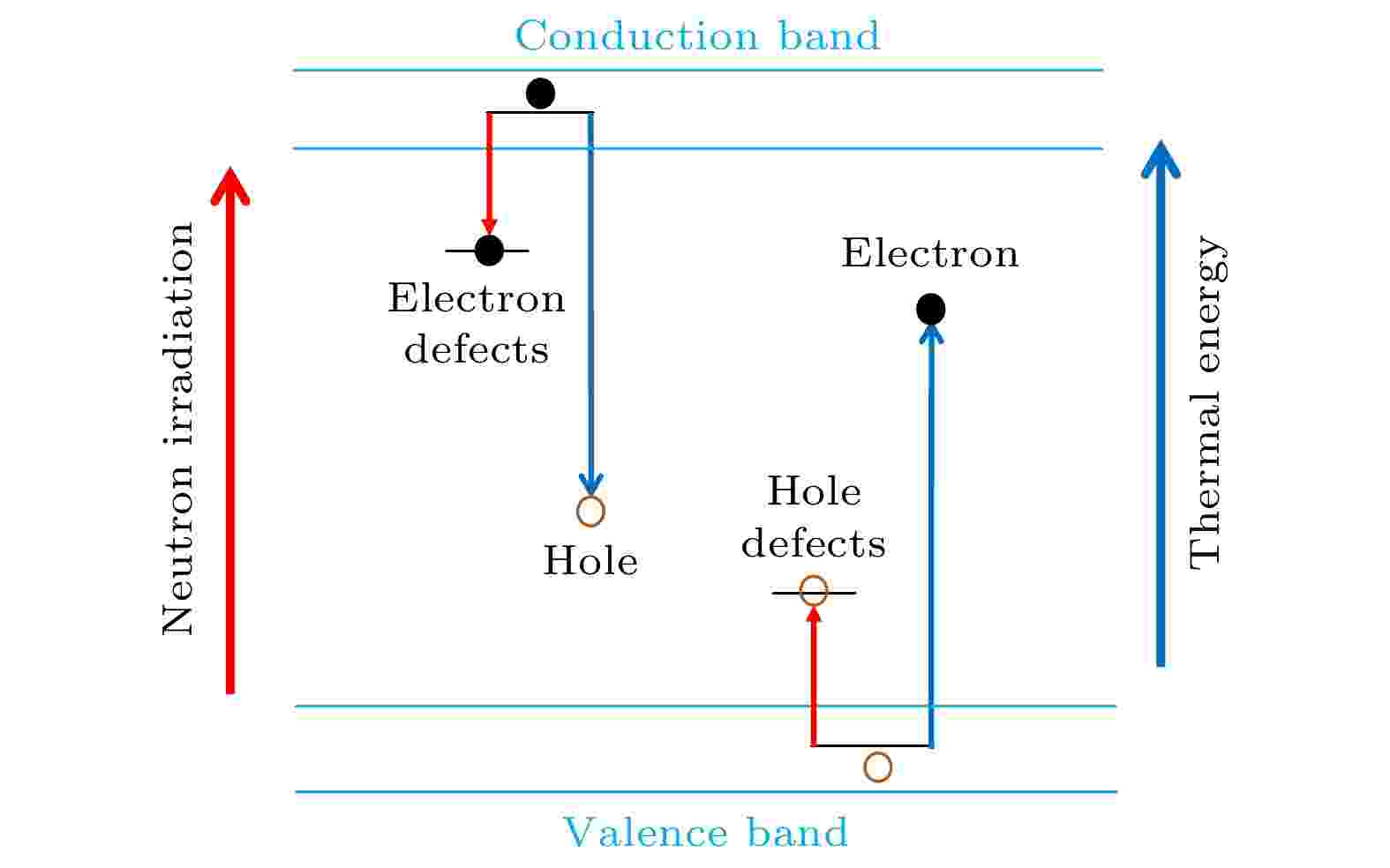 图 5 辐致色心缺陷转变模型
图 5 辐致色心缺陷转变模型Figure5. Model of radiation darkening color center defects transfer.
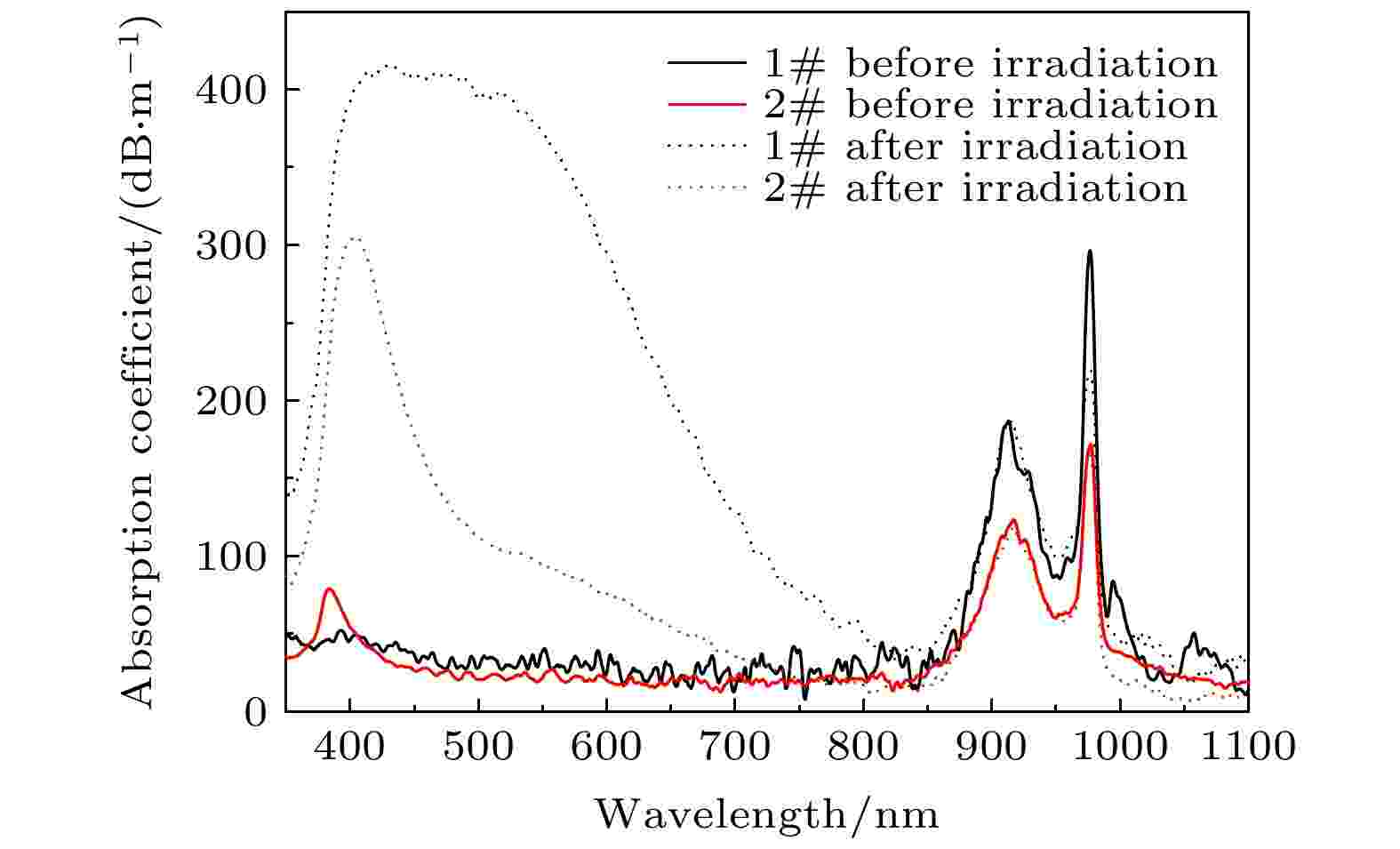 图 6 中子辐照前后光纤的吸收谱
图 6 中子辐照前后光纤的吸收谱Figure6. Absorption spectrum of optical fibers before and after neutron irradiation.
2
3.2.热退火对掺镱光纤材料中子辐致吸收的影响
中子辐照掺镱光纤材料产生的大部分色心缺陷不会在自然条件下消退[31]. 由于缺乏相关文献对中子辐照后光纤材料退火的研究. 我们自主设计了热退火参数条件, 并且在文中列出的退火条件下, 测试了光纤预制棒芯棒热退火后的吸收光谱(图7). 对比退火前后的吸收特性可以看出, 预制棒S1在可见光的吸收峰强较退火前明显下降, 芯棒颜色由棕黑色变成浅棕色. 预制棒S2退火后, 可见光区域的吸收强度基本和辐照前一致, 芯棒颜色由棕色变透明. 热退火后预制棒S2在200—400 nm的吸收强度大幅降低, 说明Ce离子参与了捕获热退火产生的电子、空穴对, 从而使热退火后S2中的Ce离子的吸收强度降低. 预制棒S2与S1相比, 由于Ce离子的抑制作用, 辐照后产生的Al-OHC等色心缺陷浓度较低, 在相同热退火条件下, 预制棒S2热退火后基本完全恢复到了辐照前的光学特性.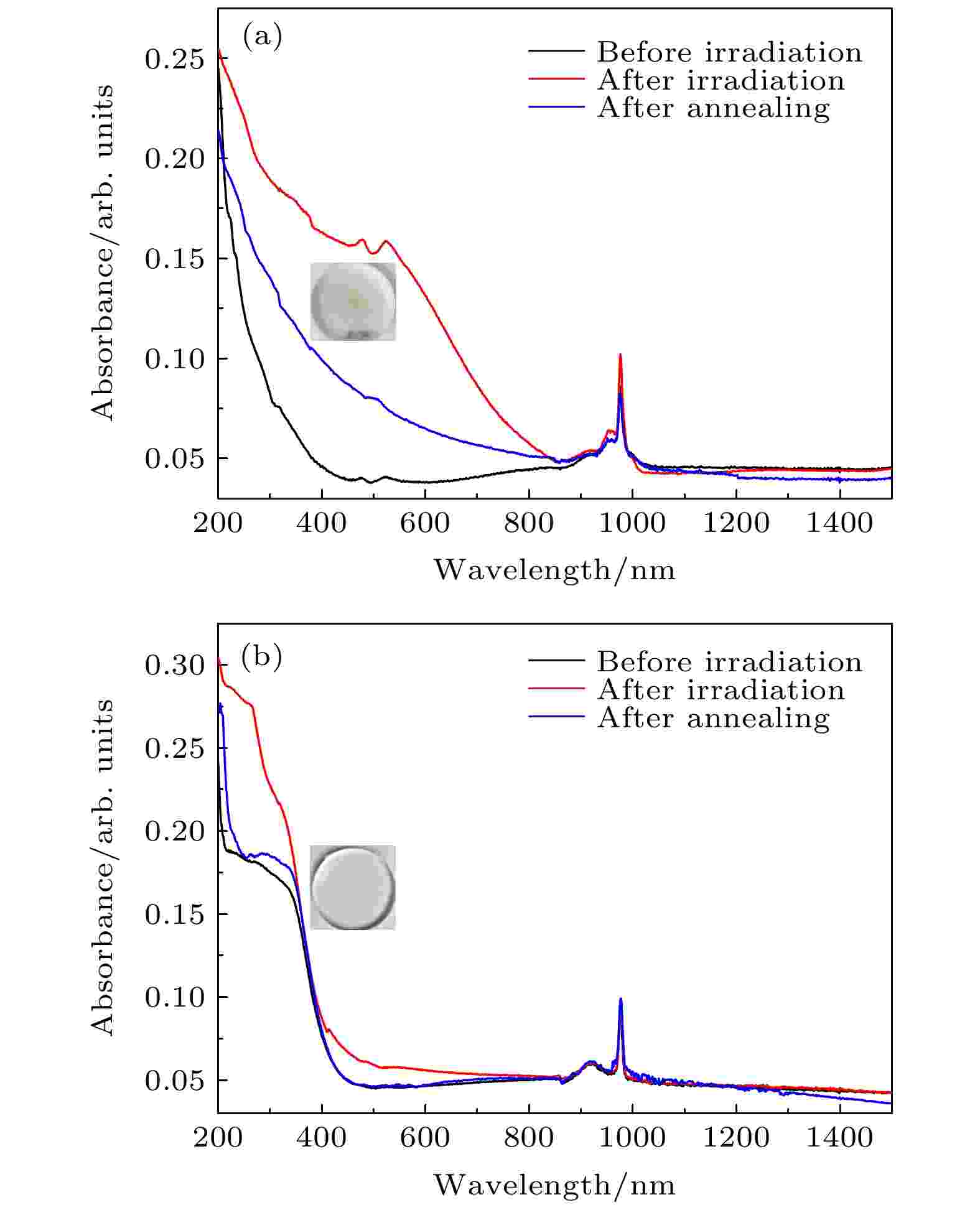 图 7 中子辐照前后及热退火后(a)掺镱光纤预制棒S1吸收光谱和(b)掺镱光纤预制棒S2吸收光谱
图 7 中子辐照前后及热退火后(a)掺镱光纤预制棒S1吸收光谱和(b)掺镱光纤预制棒S2吸收光谱Figure7. Absorption spectra of (a) optical fiber preform S1 and (b) optical fiber preform S2 before and after irradiation and after annealing.
2
3.3.中子辐照及退火对掺镱光纤材料中Yb3+光学特性的影响
表2列出了掺镱光纤预制棒辐照前后及热退火后Yb3+的荧光寿命, τ1为辐照前荧光寿命, τ2为辐照后荧光寿命, τ3为热退火后的荧光寿命. 中子辐照后两种预制棒中Yb3+荧光寿命均明显下降. 光纤预制棒S1辐照后Yb3+荧光寿命下降主要是Yb3+离子只有两个能级, 辐照后能量可从上能级转移给辐照后产生的Al-OHC色心缺陷, 再经后者通过辐射跃迁或无辐射跃迁释放出来, 这种能量传递最终导致辐照后掺镱光纤预制棒中Yb3+荧光寿命下降[14]. 而掺杂Ce离子的S2光纤预制棒辐照后也有少量Al-OHC色心缺陷, 因此两种预制棒辐照后Yb3+荧光寿命下降幅度基本一样. 退火后, 两个预制棒中Yb3+荧光寿命基本恢复到辐照前的水平, 说明热退火可在一定程度上降低Al相关的结构缺陷, 从而降低中子辐致暗化效应, 是一种较为有效的手段.| No. | t/ms | ||
| τ1 | τ2 | τ3 | |
| S1 | 0.948 | 0.749 | 0.929 |
| S2 | 0.939 | 0.747 | 0.907 |
表2辐照前后及热退火后Yb3+的荧光寿命
Table2.Fluorescence lifetime of Yb3+ before and after irradiation and after annealing.
在我们前期工作及文献调研中[4,14], 可看出中子辐照和射线辐照对掺镱光纤材料光学性能的影响较相似. 主要原因是射线和中子辐照均会发生电子电离效应产生自由电子、空穴对, 然后与材料中原有缺陷结合生成色心缺陷, 因此在光谱分析中, 两者的辐致色心缺陷的吸收拟合结果较类似. 然而射线辐照后的光纤材料在常温下很快就会发生退火效应, 因此一般光学性能测试均在辐照2 h内完成. 中子辐照后则没有这种现象. 主要原因是射线辐照能量较低时, 原子不会发生位移损伤, 辐致缺陷并不是很稳定, 因此常温退火效应明显. 而中子辐照会发生原子位移损伤[9], 因此只有热退火时才会在一定程度上降低其缺陷浓度. 射线及中子辐照过程中的辐致损伤机理应该不完全一致, 仅用光谱进行分峰拟合的手段并不能深入分析其辐致机理, 因此需要对结构缺陷进行进一步分析, 这部分工作将会是以后工作的重点.
